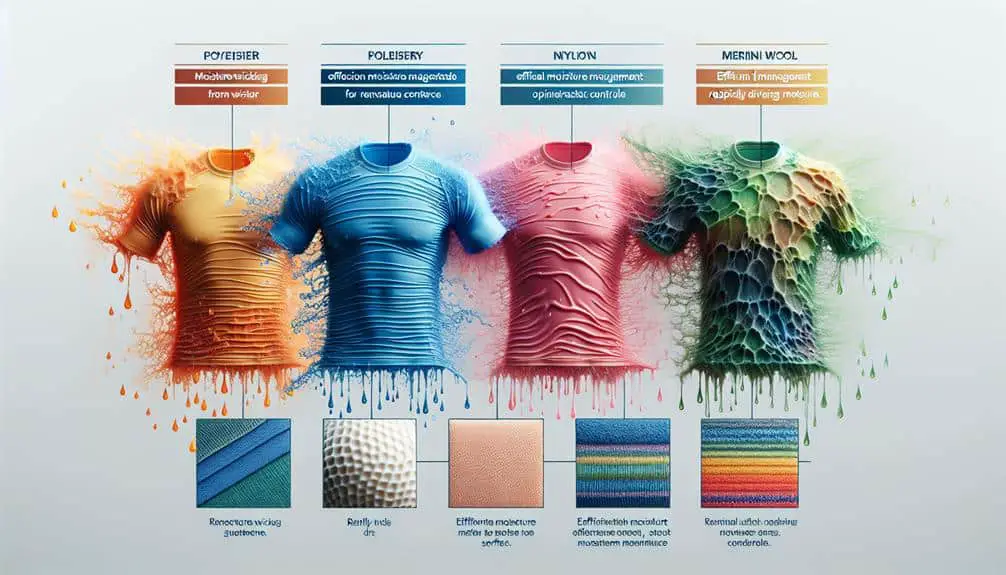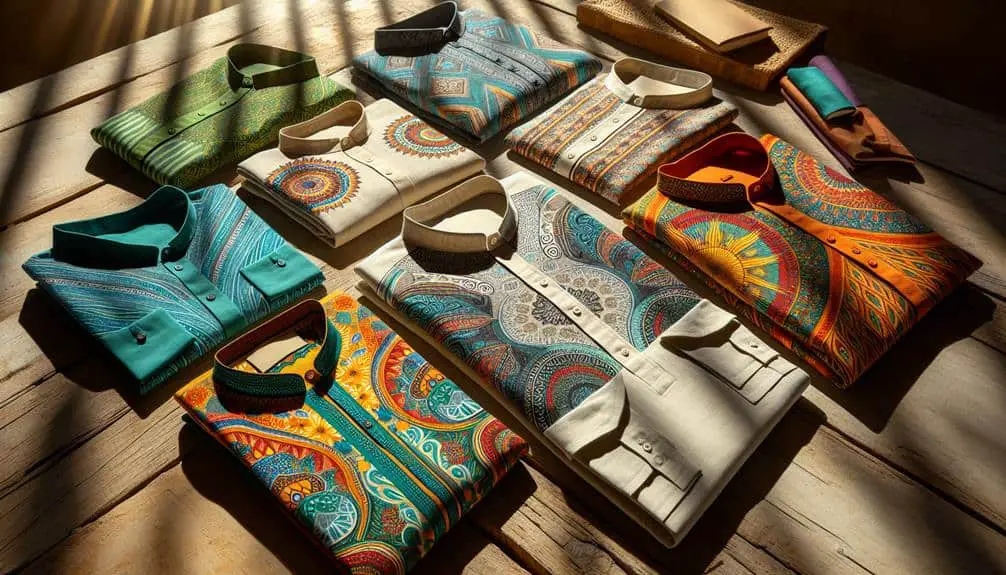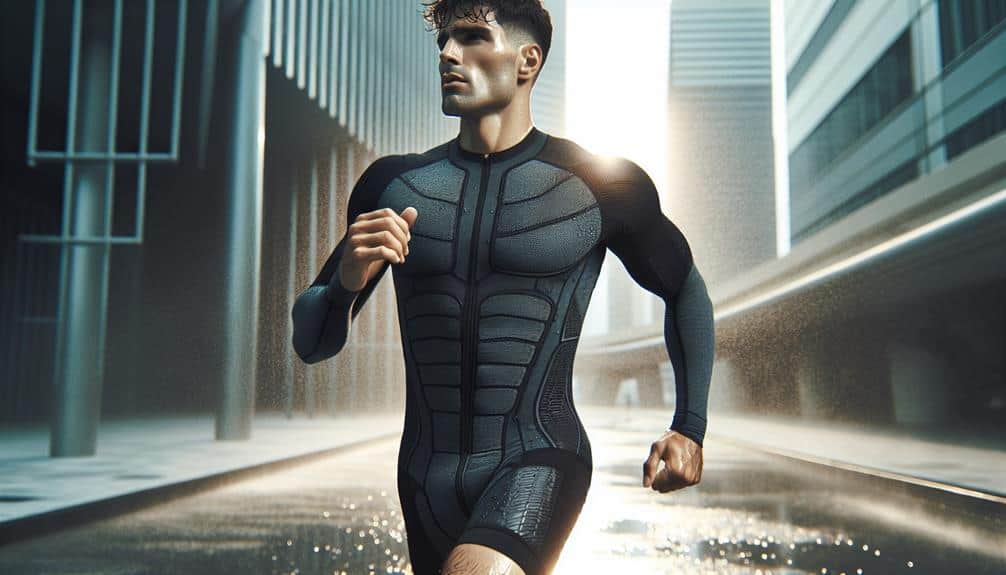For ideal temperature control, choose polyester blends with spandex or nylon, merino wool, or fabrics treated with cooling properties. These moisture-wicking fabrics excel in managing sweat and regulating body temperature. Consider fabric composition, weaves, and technology for enhanced performance. Remember to follow care instructions for maintenance. Quality fabrics like polyester and nylon offer quick-drying and durability. Fabrics combining materials and cooling properties provide a balance of benefits. Find out more about fabric choices and their benefits.
Key Points
- Prioritize polyester blends for efficient sweat management and rapid evaporation.
- Choose merino wool for excellent moisture-wicking capabilities and temperature regulation.
- Opt for fabrics treated with cooling properties for enhanced temperature control.
- Look for blends of nylon with polyester for durability and moisture management.
- Select fabrics combining technology with cooling properties for optimal temperature regulation.
Benefits of Using Moisture-Wicking Fabrics
Moisture-wicking fabrics efficiently draw sweat away from your skin, keeping you dry and comfortable during physical activities. They excel in sweat management by quickly absorbing moisture and then spreading it across a larger surface for rapid evaporation. This process helps regulate your body temperature, preventing you from feeling clammy or chilled during intense workouts.
Comfort enhancement is another key benefit of using moisture-wicking fabrics. By effectively managing sweat, these fabrics reduce the likelihood of chafing and irritation, which can be particularly bothersome during prolonged exercise. The ability to stay dry also means that you're less likely to experience skin rashes or discomfort, allowing you to focus on your performance without distractions.
Top Fabrics for Temperature Regulation
When considering fabrics for temperature regulation during physical activities, it's essential to prioritize materials that effectively manage sweat and promote rapid evaporation. Fabric technology plays a vital role in achieving this goal. Fabrics such as polyester blends with spandex or nylon are popular choices due to their moisture-wicking properties. These fabrics work by pulling sweat away from the skin to the outer surface of the fabric, where it can evaporate more easily, helping to cool the body.
Another fabric technology worth considering is merino wool. Despite being a natural fiber, merino wool has excellent moisture-wicking capabilities and is known for its temperature-regulating properties. It can keep you warm in cold weather and cool in hot weather, making it a versatile option for various activities.
Additionally, fabrics treated with cooling properties like chemical finishes or phase-change materials can provide enhanced temperature control during intense workouts or in hot climates. When selecting fabrics for temperature regulation, look for those that combine fabric technology with cooling properties for the best performance.
Factors to Consider When Choosing Fabrics
Consider fabric composition and construction when selecting materials for best performance during physical activities. Fabric selection plays an essential role in determining how well a garment can manage moisture and regulate body temperature. Look for fabrics that have outstanding moisture-wicking properties to keep you dry and comfortable during workouts. Materials like polyester, nylon, and merino wool are popular choices for their ability to draw sweat away from the skin and dry quickly, aiding in climate control.
When choosing fabrics, pay attention to the construction as well. Fabrics with special weaves or knits can enhance breathability and airflow, improving overall moisture management. Additionally, consider the weight and thickness of the fabric, as lighter materials tend to be more breathable and suitable for warmer climates, while heavier fabrics may provide better insulation in cooler conditions.
Maintenance Tips for Moisture-Wicking Shirts
To maintain the peak performance of your moisture-wicking shirts, adhere to specific care instructions provided by the manufacturer. Proper washing techniques are essential for preserving the moisture-wicking properties of the fabric. Machine wash your moisture-wicking shirts in cold water on a gentle cycle. Avoid using fabric softeners, as they can clog the fabric's pores and reduce its moisture-wicking capabilities. Instead, opt for a mild detergent that's free of harsh chemicals.
When it comes to drying methods, air drying is the best option for moisture-wicking shirts. Avoid using high heat from dryers as it can damage the fabric and affect its moisture-wicking functionality. If you must use a dryer, select the lowest heat setting and remove the shirts promptly to prevent overheating.
Comparing Different Moisture-Wicking Fabrics
Maintaining the care instructions for moisture-wicking shirts is essential for their peak performance; now, let's compare different moisture-wicking fabrics. When it comes to performance comparison, fabrics like polyester and nylon are often used in moisture-wicking clothing due to their ability to wick sweat away from the body efficiently. Polyester is known for its moisture-wicking properties and quick-drying capabilities, making it a popular choice for activewear. On the other hand, nylon is durable and offers excellent moisture management, making it ideal for intense workouts.
Fabric durability is an important factor to take into account when comparing moisture-wicking fabrics. While polyester is known for its durability and colorfastness, it may pill over time with frequent wear. Nylon, on the other hand, is incredibly strong and abrasion-resistant, making it a long-lasting choice for high-impact activities. Additionally, blends of polyester and nylon can offer a balance of moisture-wicking properties and durability, combining the best of both fabrics for top performance. When choosing moisture-wicking fabrics, take into consideration the activity level and specific needs to select the fabric that best suits your requirements.
Frequently Asked Questions
Can Moisture-Wicking Fabrics Help Prevent Odors and Bacteria Growth?
Moisture-wicking fabrics can indeed help in preventing odors and inhibiting bacteria growth. By quickly moving sweat away from your skin, these fabrics reduce the moisture that bacteria thrive on, consequently minimizing odor and bacteria concerns.
Are There Any Specific Care Instructions for Washing and Drying Moisture-Wicking Fabrics?
To maintain fabric longevity, follow care instructions for washing and drying moisture-wicking fabrics. Use gentle cycles, low heat settings, and avoid fabric softeners to preserve moisture-wicking capabilities. Stain resistance can be maintained with proper laundering techniques.
Can Moisture-Wicking Fabrics Be Used in All Types of Clothing, Such as Socks or Underwear?
You can use moisture-wicking fabrics in all types of clothing, like socks and underwear, providing comfort and dryness. For athletic wear, these fabrics enhance performance, while for sleepwear options, they regulate temperature for a better night's rest.
Do Moisture-Wicking Fabrics Have Any SPF Protection for Sun Exposure?
Moisture-wicking fabrics excel at managing sweat during physical activities. However, not all offer SPF protection. Specialized fabric technologies incorporate UV-blocking properties for sun protection. When choosing, consider the fabric's ability to wick moisture and shield from UV rays.
Are There Any Environmental Benefits to Using Moisture-Wicking Fabrics Compared to Traditional Fabrics?
Imagine moisture-wicking fabrics as eco-warriors in your wardrobe, fighting for sustainability benefits. Compared to traditional textiles, they reduce environmental impact by conserving water, energy, and resources. Embrace this eco-friendly choice for a greener future.



